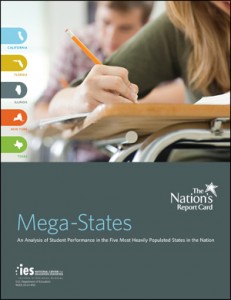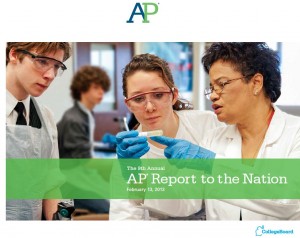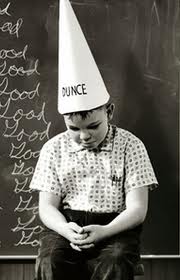Charter schools. Brooksville's first charter school, one with a STEM focus, will open this fall, reports the Tampa Bay Times. Competition from charter schools is forcing the Palm Beach County school district to think harder about its needs and priorities, reports the Palm Beach Post. Charters are also sparking debate among Palm Beach school board members about how much help they should give struggling charters, the Post also reports. An op-ed in the Miami Herald raises concerns about charter schools' diversity and financial incentives. The Sarasota Herald-Tribune profiles the principal of the Imagine charter school that is trying to break free from the parent company.
Magnet schools. The Tampa Tribune applauds the Hillsborough school district for creating a magnet tied to the maritime industry.
Alternative schools. Troubled girls get a fresh start at a sheriffs' youth ranch in Polk County. Orlando Sentinel.
 Tax credit scholarships. Great back-and-forth between scholars Kevin Welner at NEPC and Jason Bedrick at Cato, with Florida's program a big part of their debate. Cato at Liberty.
Tax credit scholarships. Great back-and-forth between scholars Kevin Welner at NEPC and Jason Bedrick at Cato, with Florida's program a big part of their debate. Cato at Liberty.
School choice. It's often partisan. Sunshine State News.
Parent trigger. Education Commissioner Tony Bennett raises a constitutional question. The Florida Current. (more…)
 For the second time this week, a credible, independent analysis shows Florida students leading the pack in progress.
For the second time this week, a credible, independent analysis shows Florida students leading the pack in progress.
Between 1992 and 2011, Florida students made bigger gains than students in four other “mega states” in fourth- and eighth-grade reading and fourth-grade math, according to a report released Thursday by an arm of the U.S. Department of Education. In each case, they moved from below the national average to meeting or exceeding it. Low-income and minority students in particular showed traction.
“There is something real going on there,” said Jack Buckley, commissioner of the National Center for Education Statistics, according to Education Week.
The center’s comparison followed Wednesday’s College Board report that showed Florida continues to climb the charts on Advanced Placement exams. The Sunshine State now ranks fourth in the percentage of high school graduates passing AP exams. Over the past decade, it ranks second in progress.
Broken-record alert No. 1: Florida’s trend lines shouldn’t be a surprise, given reports like this, this, this, this and this in the past year alone. Yet there remains a lingering perception, cultivated by critics, that Florida’s public schools are sub par and stagnant.
For Thursday’s report, the center for the first time compared scores from Florida, California, Texas, New York and Illinois – the states with the biggest student populations and arguably the biggest challenges. It used results from the National Assessment of Educational Progress, a battery of tests better known as “The Nation’s Report Card” and considered the gold standard among standardized assessments.
In eighth-grade math, Florida students made gains but remain below the national average. Elsewhere in the report, they were singled out often. (more…)
 Charter schools. An Orange County charter that served dyslexic students is closing after seven months because of financial problems, reports the Orlando Sentinel. The parents of a charter in Miami-Dade are in limbo after a church decides unexpectedly to end the school's lease, reports the Miami Herald.
Charter schools. An Orange County charter that served dyslexic students is closing after seven months because of financial problems, reports the Orlando Sentinel. The parents of a charter in Miami-Dade are in limbo after a church decides unexpectedly to end the school's lease, reports the Miami Herald.
Virtual charter schools. In a repeat of last year, the charter school appeals commission sides with the Orange and Seminole school boards in their rejection of applications for Florida Virtual Academy schools. The state Board of Education will make the final call. SchoolZone.
Parent trigger. Two civil rights groups in Florida, LULAC and the NAACP, are opposed. StateImpact Florida.
Magnet schools. Parents plead with the St. Lucie County School Board to not close an arts magnet because of budget cuts, reports TCPalm.com. A new elementary school arts academy is in the works in Okaloosa, reports the Northwest Florida Daily News.
Career and technical. A bill filed by Sen. John Legg, R-Port Richey, would allow students to substitute industry certifications for other graduation requirements, reports Gradebook. More from the Orlando Sentinel. The Pinellas school district plans to create several new career academies for middle schools and put STEM labs in every elementary school in an effort to boost career education, reports the Tampa Bay Times. River Ridge Middle School in Pasco is realigning its curriculum to better reflect career education, the Times also reports. (more…)
AP results. Florida students rank No. 4 in the nation in the percentage of graduates passing an AP exam. redefinED. Tampa Bay Times. Miami Herald. Tallahassee Democrat. Orlando Sentinel. CBS Miami. Florida Today. Associated Press. Fort Myers News Press.
 Tutoring oversight. The Tampa Bay Times elevated a handful of bad actors to taint the overall tutoring effort in Florida and ridicules a program championed by the late Sen. Ted Kennedy to help low-income families, writes Steve Pines, executive director of the Education Industry Association, in an op-ed response to the Times series and editorial.
Tutoring oversight. The Tampa Bay Times elevated a handful of bad actors to taint the overall tutoring effort in Florida and ridicules a program championed by the late Sen. Ted Kennedy to help low-income families, writes Steve Pines, executive director of the Education Industry Association, in an op-ed response to the Times series and editorial.
Teacher evals and school grades. Despite the concern of Education Commission Tony Bennett and others, the two systems are not meant to be in sync. Shanker Blog.
More conspiracy! Now in Education Week.
Class size flexibility. There's bipartisan support for a bill to provide that. StateImpact Florida.
Common Core. Florida Education Commissioner Tony Bennett talks more about the why's behind Plan B. Education Week. (more…)
Florida students ranked No. 4 among the 50 states last year in the percentage of high school graduates who passed a college-caliber Advanced Placement exam, according to a national report released Wednesday.
 Over the past decade, the report also shows, Florida students ranked No. 2 in gains.
Over the past decade, the report also shows, Florida students ranked No. 2 in gains.
Administered by the nonprofit College Board, AP exams are tied to rigorous AP courses and widely considered to be good predictors of college success. Between 2002 and 2012, the percentage of Florida graduates who passed at least one rose from 14.4 percent to 27.3 percent. Over the same span, the national rate rose from 14.3 percent to 19.5 percent.
The raw numbers better show the scale of impact. In 2002, Florida had 17,256 graduating seniors with AP success on their transcripts. In 2012, it had 39,306.
Florida’s AP success is among the most compelling signs that Florida’s once barrel-bottom public education system is progressing, particularly for low-income and minority students.
For years, AP classes were the near-exclusive domain of white and Asian students in the ‘burbs. But under former Gov. Jeb Bush, Florida began a sustained effort to give low-income and minority students more access. Higher expectations were coupled with better preparation for students, professional development for teachers and targeted investments in funding. Some districts, particularly Hillsborough, got even more radical, aiming to make AP the new normal in schools where AP courses could be counted on one hand.
The result at the school level: In 2002, students at East Bay High in rural Hillsborough took 63 AP exams and passed 36. Last year, they took 770 and passed 323.
The result at the state level: Florida outpaces wealthier, less diverse and - in the education realm - more highly regarded states like Virginia and Connecticut, and now trails only Maryland, New York and Massachusetts.
Update at 2:46 p.m.: DOE press release here. Tallahassee Democrat story here.
 Tony Bennett has a tough, tough job ahead, and the way education in Florida is covered is not going to make it any easier. The big news last week is a case in point.
Tony Bennett has a tough, tough job ahead, and the way education in Florida is covered is not going to make it any easier. The big news last week is a case in point.
Besides Bennett’s selection as the state’s new education commissioner, the top story was how Florida fourth-graders scored on a respected international test called PIRLS , which stands for the Progress in International Reading Literacy Study. In case you missed it, Florida students ranked second in reading, behind only their peers in Hong Kong. Virtually none of the state’s major daily newspapers (the Orlando Sentinel being a notable exception) covered this development, but CNN did. It interviewed interim Education Commissioner Pam Stewart live, next to an all-caps headline that read, “FLORIDA STUDENTS SCORE BIG.”
This wasn’t a one-time oversight. Over the past 10 to 15 years, Florida students and teachers – its public school students and teachers - have made impressive academic gains, whether it’s on national math and reading tests, or on college-caliber Advanced Placement tests, or in graduation rates as determined by credible, independent experts. For four years running, Education Week, looking at both performance and progress, has ranked Florida among the leading states in K-12 achievement (to be specific, at No. 7, No. 7, No. 6 and No. 12 over that span). And yet, flattering reports about Florida’s progress rarely get more than passing mention, while those who oppose the state’s accountability and school choice initiatives are often allowed to deny that such progress even exists. Even stranger, the more outrageous their statements get, the more often they seem to get quoted. (more…)
 AP pass rates. The Tampa Bay Times looks at pass rates by high school in the Pinellas school district and concludes “AP test success remains elusive.” The story includes a lot of stats, but doesn’t note the actual numbers of students and/or tests passed at each school and how that number has risen (or not) over time. For what it’s worth, the numbers of students passing AP statewide has skyrocketed (even though pass rates have dipped) because so many more students have been given the opportunity and support to succeed. Over the last five years, according to this report, the number of passed AP tests in Florida climbed from 87,852 to 136,265 - an increase of 55 percent.
AP pass rates. The Tampa Bay Times looks at pass rates by high school in the Pinellas school district and concludes “AP test success remains elusive.” The story includes a lot of stats, but doesn’t note the actual numbers of students and/or tests passed at each school and how that number has risen (or not) over time. For what it’s worth, the numbers of students passing AP statewide has skyrocketed (even though pass rates have dipped) because so many more students have been given the opportunity and support to succeed. Over the last five years, according to this report, the number of passed AP tests in Florida climbed from 87,852 to 136,265 - an increase of 55 percent.
Investigation into overspending. A probe begins into why the Manatee school district ended up $3.4 million in the red, reports the Sarasota Herald Tribune.
Interim education commissioner Pam Stewart is widely respect, but hasn’t applied for the permanent job, notes State Impact Florida.
 Editor's note: blog stars is an occasional roundup of good reads from other ed blogs.
Editor's note: blog stars is an occasional roundup of good reads from other ed blogs.
The EdFly Blog: Frivolous litigation earns dunce cap
As for Florida dumbing down education, as is alleged in the lawsuit, the state ranks first in the country in the percent of 2011 graduates who took an AP exam, sixth in the percent of graduates passing at least one AP exam, and fourth in improving the passing percentage since 2001.
An in-depth analysis by ProPublica last year praised Florida as being a leader in giving low-income students the same access to AP classes as affluent kids.
And while the state’s NAEP scores took a dip in 2011, it ranks second nationally in gains on the national assessments dating back to the 1990s.
In fact, by any measure, the state’s education system is light years ahead of the system that was in operation when Mills helped run Tallahassee. And the biggest beneficiaries have been the students who were routinely ignored back then. Full post here.
Sara Mead's Policy Notebook: This is why our current education debate is toxic
Richard Rothstein's American Prospect investigation into the details of Joel Klein's childhood (no, I'm not kidding here) is really not worth reading, but it unfortunately exemplifies two of the most toxic aspects of the current education reform conversation (fwiw it also contains some interesting information about the history of post-war public housing in NYC):
Personality over policy: The point of Rothstein's very long article seems to be that Joel Klein's education policy views are invalid because his childhood was less poor than it has sometimes been represented as being. At a surface level, this is idiotic. Whether Klein grew up in abject poverty or simply in circumstances much more humble than the financial and political status to which he has risen has absolutely nothing to do with whether the education policies he proposes work. Nor did Klein or anyone else ever claim himself as the sole data point for the power good teachers and schools can have on kids' lives. There's, um, actual research on this. (more…)
From the better-late-than-never file:
The percentage of Florida students eligible for free- and reduced-price lunch rose for the fifth straight year last year to 57.6 percent, according to the state Department of Education.
In total, 1.54 million of the state’s 2.69 million students were eligible, marking the third straight year a majority of Florida students reached that threshold, says a report posted on the DOE web site over the summer (I stumbled on the latest numbers over the weekend, and as far as I can tell, no traditional news outlets have reported them).
The report shows 78.7 percent of black students were eligible for free- and reduced-price lunch last year, compared to 71.5 percent of Hispanic students and 38.2 percent of white students.
Among the state’s biggest districts, Miami-Dade led with the highest percentage, at 71.9 percent, followed by Polk at 68.3 percent and Lee at 64.2 percent.
Since the 2003-04 school year, Florida schools have also been majority minority. Last year, 57 percent of Florida students were minorities.
Despite the challenging demographics, Florida has over the past 10 to 15 years been among the leading states on key academic indicators, including progress on NAEP, performance on Advanced Placement tests and improvement in graduation rates.
Florida’s public schools were handed another solid but overlooked report card this week from another respected, independent source.
The 27-page, data-stuffed, “Decade of Progress” progress report from the Southern Regional Education Board is yet more evidence that Florida’s public schools are making steady progress despite the claims of some critics. The trend lines are often especially strong for low-income and minority students.
For example, between 2003 and 2011, the percentage of low-income eighth-graders scoring at the basic level or above on the reading portion of the National Assessment of Educational Progress rose from 55 to 65 percent in Florida – a 10-point gain. Over the same period, the percentage of more affluent eighth-graders who reached the bar rose 5 percentage points, from 78 to 83 percent.
For each of its 16 member states, the SREB looked at a wide array of academic indicators to see how much the needle moved over the past decade, and how those gains or losses compared nationally and regionally. Besides commonly cited indicators like NAEP scores, graduation rates and AP results, the board looked at less-publicized statistics like college enrollment rates, ninth-grade “enrollment bulges” and grade-level progression in high school.
According to the report, the percentage of recent high school graduates enrolling in college in Florida increased from 57 to 71 percent between 2000 and 2010. Nationally, the numbers rose from 56 to 67 percent. Meanwhile, the percentage of college freshmen in Florida who returned for a second year remained steady at 86 percent.
The SREB report comes as Florida faces mounting criticism for its testing and accountability regimen, which many critics, including local school board members and parent groups, say has been ineffective. Despite that backdrop, the report was all but ignored by Florida media (an exception here), as was this recent report that found Florida’s graduation rates are among the fastest-rising in the nation.